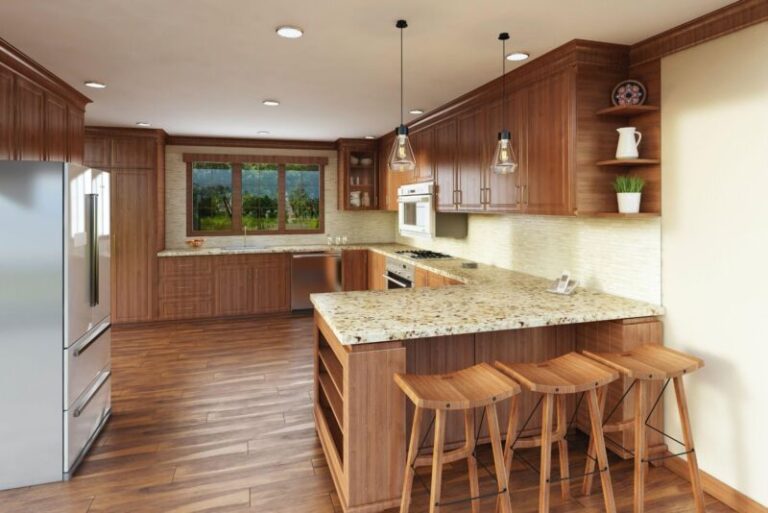It is quite easy to handle a situation where tile meets drywall outside the corner. It may appear difficult due to the complexities of getting it perfect.
Most tile installers are used to flat surfaces. This may make them fret whenever they come across corners. Some might even ignore the edge.
All buildings have edges that meet with the outside corner. There should be a clean and beautiful transition where the tile meets drywall outside the corner. And the tile should agree with the outside corner.
In this article, I’ll highlight the materials and the process you need to attach tiles to an outside drywall corner.
Ready for a Drywall Quiz?
How Do You Attach the Tile to an Outside Drywall Corner?

You will need an adhesive mastic to attach a tile to an outside drywall corner. It has a sharp grabbing quality, making it the perfect material for the job.
However, ensure you get the materials you need before starting the job.
These materials are;
- Tiles
- Trowel
- Adhesive mastic
- Measuring tape
- Tile cutter
- Course line and
- Bucket, water, and sponge
Also, you need to know the kind of tile most suitable for the job. When considering the tile type, you must ensure the color matches the one on the inside corner.
You should also look into the size and texture of the tile. You will need two trowels since you are dealing with a drywall corner.
There is a need to have a good measurement of the corners to determine the size of the tile. And if necessary, how to cut them.
Follow the procedures below to attach the tile to an outside drywall corner;
- Measure the drywall corner to which you want to attach tiles with your measuring tape.
- And use the course line to mark around the drywall corner.
- Get the tiles that you need for the job, then cut them with a tile cutter if you need to cut them.
- Use the notched trowel to apply your adhesive mastic on the tile or the wall.
- Then place the tiles on the corner and use the pointing trowel to ensure the tiles stay straight.
- Use a sponge and water to clean the tiles after finishing the work.
After you finish the job, you might try to figure out a way to cover the edge between the tiles. Leaving it bare like that is not entirely pleasing to see.
There are indeed ways you can finish the outside edge where tiles and drywall meet. This will make the work look neat and beautiful.
How to Finish the Outside Edge Where Tiles and Drywall Meet?
You can finish the outside edge where tiles and drywall meet by matching a corresponding tile at the edge where the inside tile and drywall meet.
There are different ways to finish edges where tiles and drywall meet.
Below are some methods for finishing the outside edge where drywall meets tiles;
- Caulking
- Molding
- Metal edging
- Bullnose edging
#1. Caulking
This is a very easy and stress-conserving method of finishing outside edges. It is also cost-friendly as getting a caulk is the only expense you would have to make.
This method requires you to apply caulk on the space between the two tiles to make them hold firmer. And to also give it a good outlook.
Before you caulk, make sure the edge is smooth and fine. The caulking will appear rough if the edge is rough, so always ensure a smooth surface before caulking.
#2. Molding
Most people refer to this as rail molding as it is transitional. That’s the best way to connect your outside corner to drywall.
It is suitable for use on transitions of different tilesets. But make sure the colors agree with themselves.
You can also apply rail molding for design to spice up the space. Tiles normally come with moldings which they place where there is an edge.
#3. Metal Edging
This is like the rail molding in scope. But it is more of a design kind of transition than rail molding.
Fine metals are placed at the edges where tile and drywall meet. This brings out a shiny and polished outlook to the entire tiling.
#4. Bullnose Edging
It’s a very unpopular and stressful method of finishing outside edges where tiles and drywall meet.
When you have exhausted your options for getting a material that matches your tile, consider bullnose edging.
This process involves cutting the tiles the installer used for the job into pieces. And then placing them on the edges. It takes quite a bit of experience to pull that off perfectly.
You have a handful of choices to pick from in finishing outside edges where tile and drywall meet. Choose the one that suits you and consider the complexities while choosing.
How to Transition the Outside Corner from Tile to drywall?
There is only one suitable way to transition the outside corner from tile to drywall. It is the blending tile molding process that gives the best result.
The process of transitioning can take some time because of the sophistication. It is not the usual tiling where you have to place tiles on the floor or wall and continue similarly.
In transition, you must ensure that where the inside and outside corners meet is smooth.
The process of transitioning the outside corner from tile to drywall is;
- Place the inner tile and outside tile together and ensure they fit perfectly.
- Apply your adhesive mastic to the wall and place the tiles.
- Make sure you position the tiles evenly.
- Then, use Schluter edge to cover the edge where the inside and outside tiles meet.
- Use a caulk to seal the small spaces where the tile meets with the Schluter edge.
Using a caulk to seal off any space left is a very effective way of transitioning the outside corner from tile to drywall.
However, there can be an even more efficient way of doing that. Place the Schluter edge on the wall before placing your tiles.
Place the Schluter edge at the transitioning and screw it to the wall. After attaching the border to the wall, you can apply the adhesive mastic.
Then, you can place the tiles on the wall. The Schluter edge’s design correlates with the tiles.
It is perfect for transitioning tiles. Notwithstanding, you must consider the size of the tile, texture, and color before getting a Schluter.
The Schluter should match the tile since it is transitioning it. There are different materials that they use in making a Schluter.
It could be a ceramic, wooden, or metallic Schluter. So, It all depends on the kind of material you want to use.
All the materials are very reliable and durable. The most reliable of them is the ceramic-made Schluter. You also have to consider the location of the edge.
Using a wooden or metallic Schluter in the bathroom or kitchen would be unwise. Or generally speaking, any location that is susceptible to liquid.
The design of the Schluter is also essential. Imagine working on a sharp edge, and you cannot afford to use a rounded Schluter. So consider the edge before getting the Schluter.
The table below highlights the differences between caulk and Schluter in transitioning.
| Caulk | Schluter |
|---|---|
| It is a polymer. | It is polyethylene. |
| It bonds two things together. | It is used to make two things hold. |






